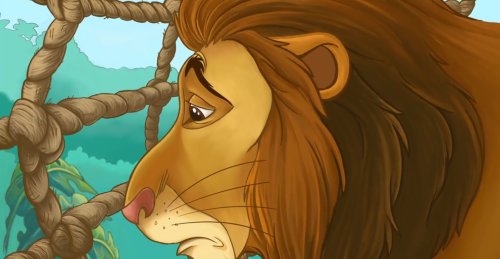
1. INGANEKWANE : UMBUSO LOSILWANE 🙎🏿♂️🦁🇿🇼
Umnxeba...
Kudala amatshe esancwebeka, lenyamazana zisakhuluma kwakukhona ujaha okwakuthiwa nguMbuso. Ngelinye ilanga uMbuso wathi esegangeni ezingela inyamazana, wadibana loSilwane.
Umnxeba...
Kudala amatshe esancwebeka, lenyamazana zisakhuluma kwakukhona ujaha okwakuthiwa nguMbuso. Ngelinye ilanga uMbuso wathi esegangeni ezingela inyamazana, wadibana loSilwane.

2. Wathi esedlula isithiyo esasenziwe ngezigodo, wezwa,“Mbuso, mngane wami, akusondele ungivulele lapha ngiphume. Sengifile liphango lokoma.” 

3. KwakunguSilwane encenga ngelizwi elihawulisayo. UMbuso wayelijaha elilesihawu njalo elilomusa. Kodwa wayeke wezwa ngendumela ezimbi zikaSilwane. Ngakho wathi, “Ngiyafuna ukukusiza. Kodwa, bayakutsho wena ukuthi ulomoya omubi. Ngizakusiza lapha ucine usungidla.”
4. Hatshi mngane wami Mbuso. Ngiyabe ngililema langaphi elingabongiyo?
“Mmh, Silwane? Uqinisile?”
“Ngiqinisile sibili, mngane wami. Ake ungizwele. Sengiyafa ngendlala.”
UMbuso waphambuka,wafika waphakamisa izigodo lezo ezazivale umjibila lowo owawuvalele uSilwane.
“Mmh, Silwane? Uqinisile?”
“Ngiqinisile sibili, mngane wami. Ake ungizwele. Sengiyafa ngendlala.”
UMbuso waphambuka,wafika waphakamisa izigodo lezo ezazivale umjibila lowo owawuvalele uSilwane.
5. Waphuma uSilwane welula imikhono le eyayisilenkantsho. Amathambo athi, qha-qha-qha!Wabe esithi, “Ya-a! Ngisake ngiyenatha amanzi ngicitshe umhawu.Ngizabuya sengikudla ngikuqhobe ngisuthe.” 

6. Wamangala uMbuso
wathuthumela wathi, “Hawu! Njani mngane? Angithi uthembisile ukuthi awusoze ungidle?"
“Uyinyama yami wena,” etsho uSilwane esekhohliwe ukuthi ubehawula encenga engakakhutshwa emjibileni.
wathuthumela wathi, “Hawu! Njani mngane? Angithi uthembisile ukuthi awusoze ungidle?"
“Uyinyama yami wena,” etsho uSilwane esekhohliwe ukuthi ubehawula encenga engakakhutshwa emjibileni.
7. Ungiqeda amathe Silwane. Kodwa kungcono kesibuze kwabanye lapha eguswini ukuthi lokho ofuna ukungenza khona mina ngikusizile kuqondile na. Kulungile yini ukwephula izithembiso?”
“Kulungile, Asibambisane indlela ngisiyanatha amanzi!”
“Kulungile, Asibambisane indlela ngisiyanatha amanzi!”
8. Khonokho nje, ngqwa loNkomo. UMbuso wabuza wathi, “Nkomo mngane, akusilamule lapha. Ngifice uSilwane evalelwe phakathi kwesithiyo, wacela ngomusa ukuba ngimkhuphe. Bengisala ngisesaba ukuthi uzangidla.
9. Kodwa uthembisile ukuthi angeke enze into yokuganga enjalo. Ngithe sengimkhuphile, nango sefuna ukungidla. Kulungile na ukwephula izithembiso?”
10. UNkomo wanwaya ikhanda wasesithi, “Muuuuuu! Ya-a, lina abantu alilazwelo. Ngisesemutsha lalingithanda ngilipha uchago. Njalo izihlobo zami zazidonsa ikhuba kulinywa zisenza leminye imisebenzi eminengi.
11. Kodwa sengigugile nginje, ngiyakwazi ukuthi sengizabulawa, kudliwe inyama, isigogo sami senziwe izambatho zenu. Ngivumelana loSilwane. Uyinyama yakhe wena!”
“Angithi uyezwa-ke?” uSilwane eveza ingavula zamazinyo ezesabekayo ekhotha ulimi.
“Angithi uyezwa-ke?” uSilwane eveza ingavula zamazinyo ezesabekayo ekhotha ulimi.
12. Wadana uMbuso wathi, “Hatshi, angisuthiseki. Ake sibuze enye inyamazana njalo. Bahlangana lobabhemi osegugile, wabika indaba uMbuso. UBabhemi wathi, “O-iii, oiii, oiii, oiii! Yebo, kuhle udliwe wena. Uyinyama kaSilwane.
13. Lilochuku lina abantu. Ngangisebenzela izihlobo zakho gadalala. Khathesi sengigugile angiselamandla, sengilahlelwa egangeni. Kuhle khonalokho na?”
UMbuso kasuthisekanga, wacela ukuthi abuze kwenye njalo inyamazana.
UMbuso kasuthisekanga, wacela ukuthi abuze kwenye njalo inyamazana.
14. USilwane wayengasela sineke, sokumphuzele ukuthi ayenatha amanzi abe esemudla uMbuso. Khonokho nje, nango uKhanka eqolotsha esedlula lapho. UMbuso wammisa wamlandisela indaba.
15. UKhanka wasondela eduzane wathi “Uthini Mbuso, kangikuzwisisi? Silwane, uqinisile yini ujaha lo ngalokho akutshoyo?”
USilwane wathi, “Ye-e! Yikholokho sibili akutshoyo.”
USilwane wathi, “Ye-e! Yikholokho sibili akutshoyo.”
16. UKhanka wema wanwaya ikhanda ekhangele phansi wathi, “Wo-o! Kodwa, angizwisisi kahle. Kungcono sihambe siye khonalapho okulesithiyo Silwane, ukuze ungitshengise lapho obukade ukhona ukuze ngibone kahle. Angikuboni elikutshoyo.”
17. Wacaphuka uSilwane ngoba sekumphuzele ukuthi amqhobe uMbuso lo. Kodwa watshitsha phambili wathi “Kulungile. Woza ngikutshengise!” Bahaluzela bebuyela emuva. Bafika uSilwane wathi “Bengivalelwe lapha!”
18. Wo-o! Ngena sibone ukuthi bekuvalwe njani kuze ngisuthiseke. UMbuso yena wayesehawula esengumhlanga emfuleni ohubayo emi lapho. “Wena Mbuso, vala sibone ukuthi bekuvalwe njani.” Waphakamisa icele lesithiyo eqhuqha uMbuso. USilwane ngeniyani. UMbuso valiyani!!!
19. Uthe eqeda, uKhanka wakhangela ngelihlo elihlekayo, wathi “Yetshwa-a-a! Sengibonile ke. Kutshukuthi wena Mbuso sungaqhubeka ngokuzingela. Wena ke Silwane zihlalele nje emjibileni wakho njengoba ubuzihlalele vele! 

• • •
Missing some Tweet in this thread? You can try to
force a refresh


















